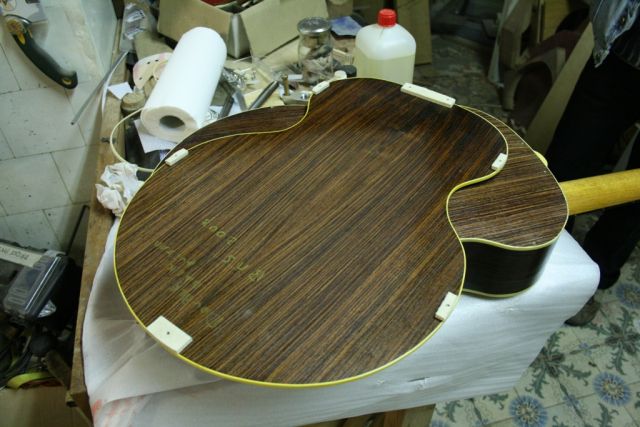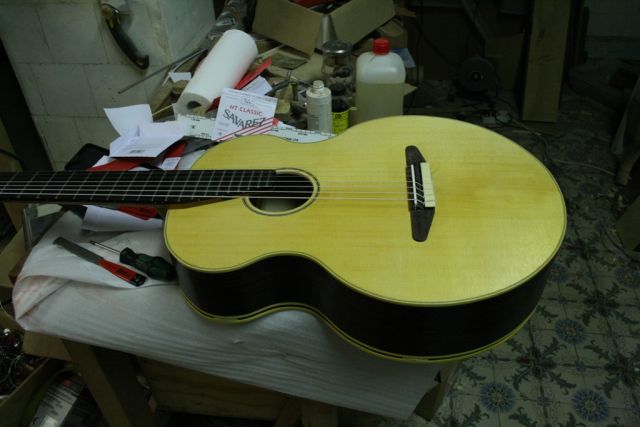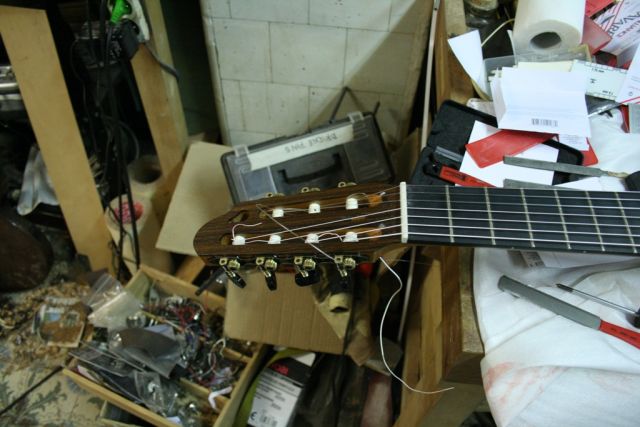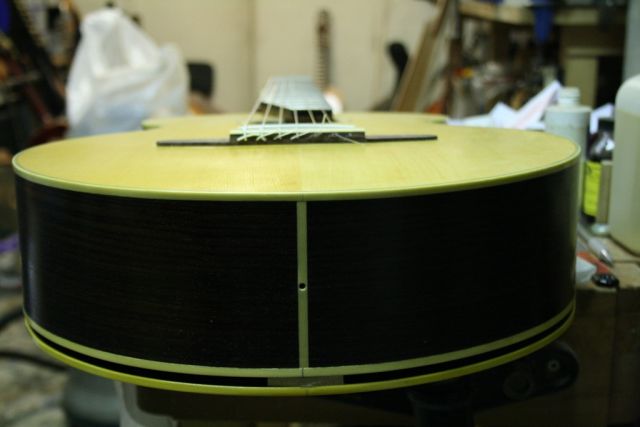ANZLF Adjustable Neck Joint Group Discussion
- Dennis Leahy
- Blackwood
- Posts: 872
- Joined: Wed Oct 10, 2007 12:32 am
- Location: Duluth, MN, US
- Contact:
Allen Wrote :
Are you talking about using a raised fret board...ie the top diving down in front of the sound hole by lets say 10 mm so the fret board is still where it's meant to be, but now there is clearance under it?[/quote]
No Allen , I wasn't referring to that type of building method. Just a normal top radius type. The fretboard has to be raised a little at the body join to allow the fretboard extension to tilt both up or down . If it wasn't raised ,the extension wouldn't have that freedom of movement without hitting the soundboard
Are you talking about using a raised fret board...ie the top diving down in front of the sound hole by lets say 10 mm so the fret board is still where it's meant to be, but now there is clearance under it?[/quote]
No Allen , I wasn't referring to that type of building method. Just a normal top radius type. The fretboard has to be raised a little at the body join to allow the fretboard extension to tilt both up or down . If it wasn't raised ,the extension wouldn't have that freedom of movement without hitting the soundboard
Craig Lawrence
I use a single piece of wood for the entire length of the neck to have a very stiff support for the fingerboard. The "flying part" has 2 graphite reinforcements inside. Usually the wood under the fingerboard is: 10mm at the body join and little less than 5mm at the end. That makes the sound to be solid all the way to the top fret. To compensate that I use a body who is 10 mm shallower at the neck than at the tail.
Cheers
Benoit
Cheers
Benoit
www.bmsguitars.com
Here's a couple of pictures to show what I did with the fretboard and top on this one.
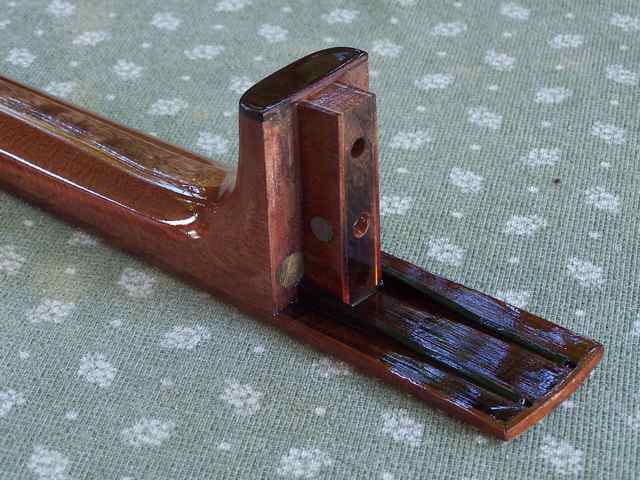
The carbon fiber rods run the length of the fret board and into the headstock, reinforcing the head plate / neck area. They were just long enough to work for this. I inlet them into the fret board 1/8 inch and into the neck by 1/4 inch. As you can see, I tapered the cf rods off as they exited the neck down to the 1/8" that is still in the fret board where it meets the sound hole.
The fret board is also bound from off cuts from itself. The extension is rock solid past the 14th fret.
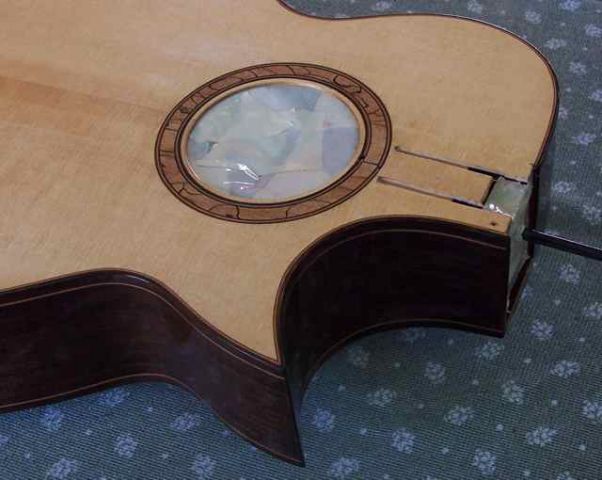
I didn't like the idea of a large cavity cut in the top in such a crucial area of the top, so this time around I took some off cuts of the top and glued in 2 layers as a reinforcement under the fret board area. The layer next to the top is a cross grain piece, the next is the same orientation as the top. They are a snug fit up against the head block, cutaway and upper transverse brace, they have a nice taper out on the upper bout side to help reduce a stress riser. I don't know if it ever would be an issue, but it was easy to do, so hopefully better safe than sorry.
As you can see, the slots cut for the carbon fiber rods penetrate the top, but there still is the 2 layer reinforcement the help keep the tops integrity.

The carbon fiber rods run the length of the fret board and into the headstock, reinforcing the head plate / neck area. They were just long enough to work for this. I inlet them into the fret board 1/8 inch and into the neck by 1/4 inch. As you can see, I tapered the cf rods off as they exited the neck down to the 1/8" that is still in the fret board where it meets the sound hole.
The fret board is also bound from off cuts from itself. The extension is rock solid past the 14th fret.

I didn't like the idea of a large cavity cut in the top in such a crucial area of the top, so this time around I took some off cuts of the top and glued in 2 layers as a reinforcement under the fret board area. The layer next to the top is a cross grain piece, the next is the same orientation as the top. They are a snug fit up against the head block, cutaway and upper transverse brace, they have a nice taper out on the upper bout side to help reduce a stress riser. I don't know if it ever would be an issue, but it was easy to do, so hopefully better safe than sorry.
As you can see, the slots cut for the carbon fiber rods penetrate the top, but there still is the 2 layer reinforcement the help keep the tops integrity.
- Dave White
- Blackwood
- Posts: 452
- Joined: Mon Nov 12, 2007 3:10 am
- Location: Hughenden Valley, England
- Contact:
Allen,
Nice engineering. I think that Mike Doolin uses the dadoed cf rods in a similar way as well as Rick Turner. If you are using buttress braces in the body then a hole in the centre for the fingerboard extension isn't a structural issue at all imho. My preference is for the neck stock to continue up as far as possible into the body in the fully floating fbe, and it also has the cf rods going all the way up here. My thinking is you get a more constant tone as you fret up the neck but the cf rods on their own could well do this. That's the beauty of making these things - lots of horses for courses.
Nice engineering. I think that Mike Doolin uses the dadoed cf rods in a similar way as well as Rick Turner. If you are using buttress braces in the body then a hole in the centre for the fingerboard extension isn't a structural issue at all imho. My preference is for the neck stock to continue up as far as possible into the body in the fully floating fbe, and it also has the cf rods going all the way up here. My thinking is you get a more constant tone as you fret up the neck but the cf rods on their own could well do this. That's the beauty of making these things - lots of horses for courses.
Dave White
[url=http://www.defaoiteguitars.com]De Faoite Stringed Instruments[/url]
[url=http://www.defaoiteguitars.com]De Faoite Stringed Instruments[/url]
Thanks Dave, I like this design better than the one I used on the Size 5. It's still a work in progress. The next time around I'll make sure that the upper neck bolt is in line with the yaw adjustment. I was trying to get the yaw adjustment as high to the top as possible so as not to screw up the intonation if a neck adjustment was necessary. I got the upper neck bolt about as high as possible while still being accessible from the inside.
- cactus bum
- Myrtle
- Posts: 72
- Joined: Tue Jun 10, 2008 3:19 am
- Location: Arizona
Thank you one and all, you clever Tom Edisons . When you'all get to a point where you are pretty satisfied with your joint design effort could someone post a working drawing for the sake of new readers who don't want to wade through seven pages of process to get to the product? I think I understand the refinements to date, but I am not entirely sure which elements have been discarded and which have been kept, eg washers, jam nuts, etc. Of course, at this stage the individual will pick and choose between what he likes and what he doesn't .
By the way, this joint design process you have been through has my full respect. For me, this was very interesting and fulfilling, and I was merely a spectator on the sidelines. Anyone who thinks you should keep to your workshops and "Just do it" is missing some rewarding bits of this life. Cheers, Michael Pollard
By the way, this joint design process you have been through has my full respect. For me, this was very interesting and fulfilling, and I was merely a spectator on the sidelines. Anyone who thinks you should keep to your workshops and "Just do it" is missing some rewarding bits of this life. Cheers, Michael Pollard
Allen wrote:The next time around I'll make sure that the upper neck bolt is in line with the yaw adjustment. I was trying to get the yaw adjustment as high to the top as possible so as not to screw up the intonation if a neck adjustment was necessary. I got the upper neck bolt about as high as possible while still being accessible from the inside.
Allen , Way back in this thread ,it concerned a number of folk that the intonation would be a problem with a tilt neck . I would go as far as to say some are paranoid about it.
My calculations showed that a .5 mm lowering of the strings at the 12th fret increased the string length by .094 mm. ( that's only about 3 1/2 thou ! ) Of no concern whatsoever ! Let me repeat what has already been discovered and agreed upon . "The intonation issue is of no concern ! "
This calculation was based on having a tilt point 30 mm. away from the fretboard surface. ( that's nearly 1 3/16 " ! ) which allows a heap of room.
It has allowed me to have a continuous neck under the fretboard extention without sweating about any intonation problems. I'm like Dave here, and prefer some solidity under the extension. Rick Turner had stated earlier that just carbon fibre under the fretboard extension allows some flex.
I wouldn't sweat getting the top bolt as close as you have , when there isn't really a problem to begin with. You have also negated the whole idea of having an external adjuster, by having the top bolt out of line with the pivot points . Means you still have to dive into the soundhole to readjust the top bolt each time you make an adjustment to the lower external adjuster.
The point of having an external adjuster was to make action adjustment extremely simple ,,,i.e. just one external hex screw to adjust , and without having to lower string tension. I have two necks in progress with this ( and my captured screw system ) and have found no reason to change plans.
Good to have you with us Michael. Probably better to read this whole thread so you can get a better handle on the subject. I have a plan of my captured screw system above on this page ( and elsewhere in this thread ) , but there have been other ideas put forward as well . At the end of the day ,it's really up to each individual builder to choose which system might suit them . I believe mine to be the best of course !
Craig Lawrence
- Dennis Leahy
- Blackwood
- Posts: 872
- Joined: Wed Oct 10, 2007 12:32 am
- Location: Duluth, MN, US
- Contact:
I think I have a good ear, but no indication that I have an incredible ear. On the one guitar I built with an adjustable neck, when I adjust the neck (probably .5mm) I hear a change in the intonation. I'm not talking about a strobe tuner sensing it; I hear it. Not trying to be a turd in a punch bowl, but I want to honestly report that so that if someone else builds an adjustable neck and hears an intonation change upon tilting the neck, they won't think it is impossible to hear. I do realize that fingertip pressure in fretting, the "touch" of the player, is much more significant than the slight difference in length of the string before and after adjustment. I also realize that DADgad tuning, with so many strings in octaves, and my playing style (mixing harmonics with open drones and fretted notes) may be just the ticket to underscore the slight difference in intonation. YMMV.
However, I am warming up to the concept of an external adjuster! So, don't throw me to the sharks just yet!
Dennis
However, I am warming up to the concept of an external adjuster! So, don't throw me to the sharks just yet!
Dennis
Another damn Yank!
- Dave White
- Blackwood
- Posts: 452
- Joined: Mon Nov 12, 2007 3:10 am
- Location: Hughenden Valley, England
- Contact:
If you have intonation issues when you make neck angle adjustments then if you have made the joint with the top two set screws you have an immediate get out of jail card - I know you have to slacken the strings to do this. It's probably best to get your "favourite" action set up this way and then fine-tuning/humidity adjustments should be fine intonation wise using just the adjustment bolt.
Dave White
[url=http://www.defaoiteguitars.com]De Faoite Stringed Instruments[/url]
[url=http://www.defaoiteguitars.com]De Faoite Stringed Instruments[/url]
Dennis , You're not winding me up are you ? 
 If I recall correctly , you got the design wrong on that guitar by misinterpreting Doolin's design ,and ended up having the pivot point way more than 30mm. from the fretboard. This would of course affect the intonation somewhat .
If I recall correctly , you got the design wrong on that guitar by misinterpreting Doolin's design ,and ended up having the pivot point way more than 30mm. from the fretboard. This would of course affect the intonation somewhat .
My calculations of a string length increase of .094mm. ( 3.7 thou. ) are correct when lowering the string height .5mm from the 12th fret. This being based on a pivot of 30 mm. lower than the fretboard surface ( lots of room ! ).
3.7 thou is so little , as to make virtually no difference in intonation. I'll bet there aren't many able to position their bridge to within 3.7 thou !, . Again ! ,, it is of no concern . Varying fretting pressure alone ,can make a bigger difference.
Michael , I must make mention to a change I've made to my plan above. It was pointed out by others in this thread that a barrel nut for the captured screw to engage ,would be extremely difficult to replace should that situation ever arise. I have since changed to a T-Nut in the headblock instead. These would not only make replacement a snack , but also offer better alignment with the captured screw upon installation . The play in the T-Nut's thread allows 1.5 degree of angle play within it's thread , which is ample. Even so , it's very important that the T-Nut's hole in the headblock be drilled with great accuracy.
To achieve this , it is better to leave the lower hole in the headblock until the guitar body and neck are complete.
Install the neck with top bolt in place . Establish the neck's angle by using a straight edge along the frets , and measuring your clearance above the bridge .Once you are happy with the correct angle , place a tempory piece of wood or plastic or whatever , between the lower tenon and mortice to hold this angle . Now , with the captured screw removed from the heel, use it's 6mm. hole as a drill bit guide to drill through the headblock. This will give you the exact placement ( AND ANGLE ! ) for that hole.
Your new 6mm. hole in the headblock will now need to be carefully increased to 7.5 mm to accomodate the T-Nut.
Smear a little epoxy on the T-Nut and place in it's position ( from through the soundhole )
Reassemble the captured screw in the heel and use it to hold the T-Nut in place until the epoxy sets ( Wax the screws thread first ! ).
The T-nut looks a bit crap in my opinion , so I have added a cap for appearance sake, Thus ;
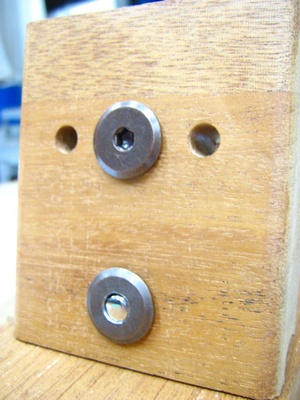
Also , an important part of my captured screw design is the brass ferrule in the heel. This increases the bearing surface of the screw to not only the 1/2 "of brass dowel used in the ferrule , but also the walls of that ferrule ,as it is epoxied in place.
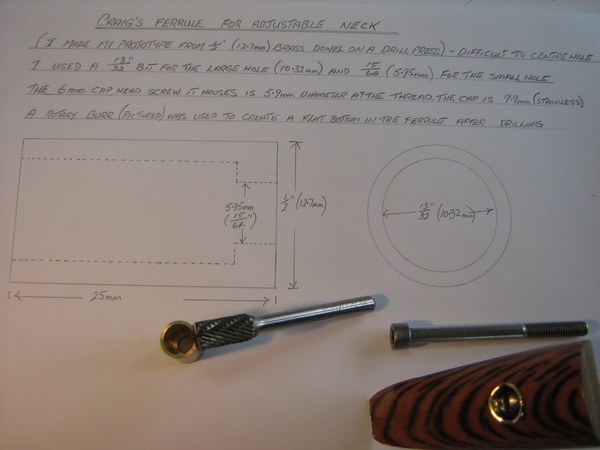
I'm sure these ferrule's could be made easier on a lathe, but not having one , I made do with a drill press. The floor of the ferrule should be around 4mm. thick
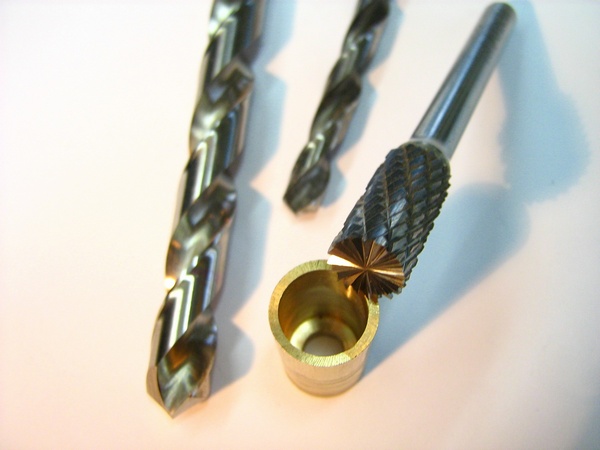
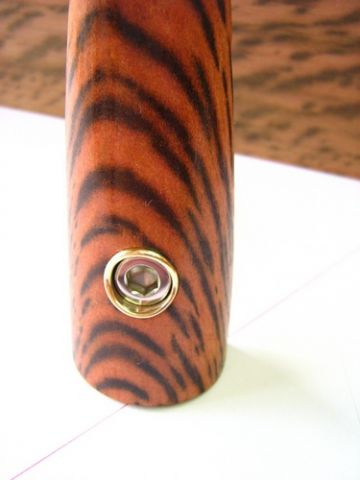
I would hope that folk employing any one of the plans offered on this thread , do the right thing , and give credit to the original designer ! Not claim it as their own , as I have seen recently !
My calculations of a string length increase of .094mm. ( 3.7 thou. ) are correct when lowering the string height .5mm from the 12th fret. This being based on a pivot of 30 mm. lower than the fretboard surface ( lots of room ! ).
3.7 thou is so little , as to make virtually no difference in intonation. I'll bet there aren't many able to position their bridge to within 3.7 thou !, . Again ! ,, it is of no concern . Varying fretting pressure alone ,can make a bigger difference.
Michael , I must make mention to a change I've made to my plan above. It was pointed out by others in this thread that a barrel nut for the captured screw to engage ,would be extremely difficult to replace should that situation ever arise. I have since changed to a T-Nut in the headblock instead. These would not only make replacement a snack , but also offer better alignment with the captured screw upon installation . The play in the T-Nut's thread allows 1.5 degree of angle play within it's thread , which is ample. Even so , it's very important that the T-Nut's hole in the headblock be drilled with great accuracy.
To achieve this , it is better to leave the lower hole in the headblock until the guitar body and neck are complete.
Install the neck with top bolt in place . Establish the neck's angle by using a straight edge along the frets , and measuring your clearance above the bridge .Once you are happy with the correct angle , place a tempory piece of wood or plastic or whatever , between the lower tenon and mortice to hold this angle . Now , with the captured screw removed from the heel, use it's 6mm. hole as a drill bit guide to drill through the headblock. This will give you the exact placement ( AND ANGLE ! ) for that hole.
Your new 6mm. hole in the headblock will now need to be carefully increased to 7.5 mm to accomodate the T-Nut.
Smear a little epoxy on the T-Nut and place in it's position ( from through the soundhole )
Reassemble the captured screw in the heel and use it to hold the T-Nut in place until the epoxy sets ( Wax the screws thread first ! ).
The T-nut looks a bit crap in my opinion , so I have added a cap for appearance sake, Thus ;

Also , an important part of my captured screw design is the brass ferrule in the heel. This increases the bearing surface of the screw to not only the 1/2 "of brass dowel used in the ferrule , but also the walls of that ferrule ,as it is epoxied in place.

I'm sure these ferrule's could be made easier on a lathe, but not having one , I made do with a drill press. The floor of the ferrule should be around 4mm. thick


I would hope that folk employing any one of the plans offered on this thread , do the right thing , and give credit to the original designer ! Not claim it as their own , as I have seen recently !
Craig Lawrence
- Dennis Leahy
- Blackwood
- Posts: 872
- Joined: Wed Oct 10, 2007 12:32 am
- Location: Duluth, MN, US
- Contact:
Hi Craig,
It was the Grant Goltz design I misinterpreted, not Doolin's. My mistake did not lower Grant's pivot point, I moved it straight back toward the bridge. (My pivot point was at the end of the tenon, and Grant's is at the neck heel.) I offered that tidbit to put all cards on the table, but I think I measured in CAD that there could be as much as .004" difference from "buzzingly low" to "resonator high" action. I read somewhere, a long time ago, that a fret misplaced by .005" could be detected by players with good ears. Could be BS, I don't know.
Anyway, since I did hear a difference in intonation on that guitar, I did include setscrews on my latest, as intonation adjustment points as well as to set the original string length and neck yaw. So, though I hope you and Dave are right, I have hedged my bet. I have heard Dave play, and he's light-years better than I am and I know he plays in altered/dropped tunings, so the point may very well be moot. Just consider me the madman babbling in the corner.
I have heard Dave play, and he's light-years better than I am and I know he plays in altered/dropped tunings, so the point may very well be moot. Just consider me the madman babbling in the corner.
Dennis
It was the Grant Goltz design I misinterpreted, not Doolin's. My mistake did not lower Grant's pivot point, I moved it straight back toward the bridge. (My pivot point was at the end of the tenon, and Grant's is at the neck heel.) I offered that tidbit to put all cards on the table, but I think I measured in CAD that there could be as much as .004" difference from "buzzingly low" to "resonator high" action. I read somewhere, a long time ago, that a fret misplaced by .005" could be detected by players with good ears. Could be BS, I don't know.
Anyway, since I did hear a difference in intonation on that guitar, I did include setscrews on my latest, as intonation adjustment points as well as to set the original string length and neck yaw. So, though I hope you and Dave are right, I have hedged my bet.
Dennis
Another damn Yank!
- Dennis Leahy
- Blackwood
- Posts: 872
- Joined: Wed Oct 10, 2007 12:32 am
- Location: Duluth, MN, US
- Contact:
I think everyone has to be very careful before laying claim to any engineering idea as "original", even if the idea appeared in this thread. When I have checked out some guitar patents, I was astounded by how broad the strokes are that are evidently legally allowed when describing an idea using text. The patent drawings are typically shown as just a single variant of the idea.Craig wrote:... I would hope that folk employing any one of the plans offered on this thread , do the right thing , and give credit to the original designer ! Not claim it as their own , as I have seen recently !
Then, there are the historical precedents that we may be unfamiliar with. I have "re-invented" some of the inventions of Tilton and Ned Steinberger. I did it on my own, with my own noodle, and later found out that I simply did not do enough research on the history to know that it had been tried before. Some of the ideas expressed in this thread may even be included in existing instruments by contemporary luthiers.
Finally, there are the concepts that are really in the "public domain" as tried and tested solutions for a variety of problems, and some people like to take those ideas and re-present them as "unique" simply because they are now applied to a guitar. A case of this (IMO) is the access panel patent by Abe Wechter. (sp?) I would bet there are VERY few commercial cabinetmakers and architectural millworkers that have not put an access door in a cabinet, box, or millwork, to allow access to plumbing, wiring, etc. An access panel on a guitar box is NOT a novel, unique, and new idea at all. In my opinion, there are several ideas presented in this thread that are re-hashing of ideas clearly in the public domain.
So, unless someone plans to take an idea and spend the money to patent it, may I recommend that collaborative, group brainstorming threads on a public luthier forum is probably not the place to make a claim of "invention", but rather of being a contributor in an open collaboration.
Dennis
Another damn Yank!
- matthew
- Blackwood
- Posts: 1190
- Joined: Mon Oct 08, 2007 1:16 pm
- Location: Sydney, Inner West
- Contact:
when you say you hear intonation difference, you DO mean "intonation", not "tuning", I assume??
I'm amazed that a string length difference that small could really make an audible difference. I would have though the changing pressure of the players fingers on the strings would have every bit as big an effect. And how would you separate one from the other?
I could be wrong. Has happened ...
I'm amazed that a string length difference that small could really make an audible difference. I would have though the changing pressure of the players fingers on the strings would have every bit as big an effect. And how would you separate one from the other?
I could be wrong. Has happened ...
- Dave White
- Blackwood
- Posts: 452
- Joined: Mon Nov 12, 2007 3:10 am
- Location: Hughenden Valley, England
- Contact:
Dennis,
I think that you have to make an adjustable neck system with a view in mind as to what you want the adjustability to do. The system that adjusts the neck angle around a pivot is, in my view, best suited to let the builder set the height of the strings above the soundboard to a height that sits with the design of the guitar to give a certain sound/driving of the top, and then lets the player make action adjustments within a certain range, either to sit with the attack and dynamics that the player wants or to cope with climatic changes to keep a constant action. The system can be set within this range and the upper set screws give the ability to home in optimally in different ranges.
On the other hand, if you want to go from super slinky strat set up to Weissenborn, then something like the Babitcz straight up and down system may be more suited (together with adjustable height nuts and saddles).
If you go to very high actions then many of the intonation issues come from having to push the strings down so hard to fret them.
I agree with you on the "very little is new" issue if you look hard enough back through time. I think the best way to deal with this is think of it as passing the baton on a relay race. It is better to make the knowledge available in the "gene pool" rather than worry about people acknowledging what you have come up with. I've seen a couple of things recently where what I thought were things I had evolved appeared as others innovations. I thought briefly about not showing my work on forums - but only briefly. Acknowledge where you can but in the end pass on the info.
I think that you have to make an adjustable neck system with a view in mind as to what you want the adjustability to do. The system that adjusts the neck angle around a pivot is, in my view, best suited to let the builder set the height of the strings above the soundboard to a height that sits with the design of the guitar to give a certain sound/driving of the top, and then lets the player make action adjustments within a certain range, either to sit with the attack and dynamics that the player wants or to cope with climatic changes to keep a constant action. The system can be set within this range and the upper set screws give the ability to home in optimally in different ranges.
On the other hand, if you want to go from super slinky strat set up to Weissenborn, then something like the Babitcz straight up and down system may be more suited (together with adjustable height nuts and saddles).
If you go to very high actions then many of the intonation issues come from having to push the strings down so hard to fret them.
I agree with you on the "very little is new" issue if you look hard enough back through time. I think the best way to deal with this is think of it as passing the baton on a relay race. It is better to make the knowledge available in the "gene pool" rather than worry about people acknowledging what you have come up with. I've seen a couple of things recently where what I thought were things I had evolved appeared as others innovations. I thought briefly about not showing my work on forums - but only briefly. Acknowledge where you can but in the end pass on the info.
Dave White
[url=http://www.defaoiteguitars.com]De Faoite Stringed Instruments[/url]
[url=http://www.defaoiteguitars.com]De Faoite Stringed Instruments[/url]
- Dennis Leahy
- Blackwood
- Posts: 872
- Joined: Wed Oct 10, 2007 12:32 am
- Location: Duluth, MN, US
- Contact:
Hi Matthew,matthew wrote:when you say you hear intonation difference, you DO mean "intonation", not "tuning", I assume??
I'm amazed that a string length difference that small could really make an audible difference. I would have though the changing pressure of the players fingers on the strings would have every bit as big an effect. And how would you separate one from the other?
I could be wrong. Has happened ...
I'll reassemble the eohippus so I can flog it some more. It's true that I am fuzzy on how to separate an intonation issue from an issue where the intonation appears to be off when the string is high enough that it requires more distance to be brought down to the fret.
I think of intonation as: harmonic at the 12th vs. fretted note at the 12th. I think of that fretted note as using the least possible amount of pressure to get the string to touch the fret. Pushing the string harder than that minimum sharpens the fretted note. (I see that as a different issue - let's assume the least amount of force is used.)
So, for a particular player, string action height is set low, and the saddle is intonated. A song is written that uses harmonics at the 12th, notes fretted at the 10th and 11th, along with notes from open strings. It sounds pretty sweet to the player's ears - intonation appears correct.
Time elapses. (Enough time for a new guitar to settle in.) New strings. The player decides to play that song again, but finds it impossible to fret the notes without sending them slightly sharp. Tuning those strings lower means the fretted notes sound correct, but if those strings are played open or as harmonics, they sound flat. Player checks intonation (lightly fretted notes at 12th vs. harmonics at 12th, and finds the intonation is off. At the same time, the player notes that the action is higher than when the original saddle intonation was done.
Player adjusts adjustable neck, dropping action (somewhere in the range of .5mm to .75mm - player is not sure he really remembers - player used to smoke a lot of pot.) Player notes that with drop in action, intonation is correct again. Player thinks about rolling a fattie, but, inspired once again by the guitar, player decides to play instead.
So, is it fair to call that an intonation issue related to change in length of the string by rotating the neck? Or is is more accurate to say that without movable saddles, a guitar's intonation will only be correct at one specific action height? I think they are both true, and it is just a matter of semantics. But, like I said I'm fuzzy on the concept. (Contact high from being in the room with that dope smoking player?)
Hi Dave,Dave White wrote: if you want to go from super slinky strat set up to Weissenborn, then something like the Babitcz straight up and down system may be more suited (together with adjustable height nuts and saddles).
As a separate (and really moot) issue, if you think of raising the action on a Babicz guitar by 10", then measure the string length, you'd find a drastic difference in string length. Raise the action by 1" and though less drastic, the string length would have lengthened considerably. Raise the action by .1", and most players may not be able to discern the difference in string length, but the string length (and intonation) does change. I'm not trying to spank Babicz - his adjustable neck system might be the best on the market - but I believe the claim that the string length does not change is inaccurate. The only thing I can think of that could really make that claim would be the cam system that I mentioned, where a turn of the cam would both change the height of the string action and compensate the string length change (or, as you caught, the addition of height adjustable saddles to Babicz's system.) Taking that cam idea one step further, it would not be enough to make sure that the string length remained static (via compensation) as the action height changed, because a higher action would require more distortion of string length to fret a note. So, the compensation would not ideally be a 1:1 ratio, but would need to slightly undercompensate string length as the action was raised. I know I'm out there in "how many moot points can dance on the head of a pin" territory with this. I am going to use bolts, with setscrews, knowing that the setscrews could, if required, re-set the intonation without making a new saddle.
Dennis
Another damn Yank!
- Dave White
- Blackwood
- Posts: 452
- Joined: Mon Nov 12, 2007 3:10 am
- Location: Hughenden Valley, England
- Contact:
- Dave White
- Blackwood
- Posts: 452
- Joined: Mon Nov 12, 2007 3:10 am
- Location: Hughenden Valley, England
- Contact:
- Dave White
- Blackwood
- Posts: 452
- Joined: Mon Nov 12, 2007 3:10 am
- Location: Hughenden Valley, England
- Contact:
- Dennis Leahy
- Blackwood
- Posts: 872
- Joined: Wed Oct 10, 2007 12:32 am
- Location: Duluth, MN, US
- Contact:
- Dennis Leahy
- Blackwood
- Posts: 872
- Joined: Wed Oct 10, 2007 12:32 am
- Location: Duluth, MN, US
- Contact:
Who is online
Users browsing this forum: No registered users and 36 guests
